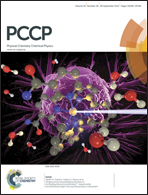Cage-like effect in Au–Pt nanoparticle synthesis in microemulsions: a simulation study
Abstract
The different distributions of metals in bimetallic nanoparticles synthesized in microemulsions were studied by computer simulation. The simulations demonstrated that if the difference between the reduction potentials of both metals is about 0.15–0.3 V, the compartmentalization of the reaction media causes the accumulation of slower reduction reactants in the microemulsions droplets, which favours the chemical reaction like a cage effect: increasing the local concentration of the slower reduction metal salt gives rise to a faster reduction, so the differences in reduction rates of both metals are attenuated. A more coincidental reduction of both metals deeply affects the nanoparticle structure, causing a better mixed alloy. This effect will be more pronounced when the concentration is higher and the intermicellar exchange rate is faster. This means that for any fixed microemulsion the nanoparticle structure can be modified by changing the reactant concentration: the core can be enriched in the faster reduction metal by lower concentrations, and the shell can be enriched in the slower metal by higher concentrations. Based on these observations, this study suggests a route to help experimentalists better create nanoparticles with a pre-defined structure.


 Please wait while we load your content...
Please wait while we load your content...